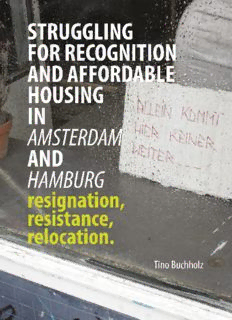
Struggling for recognition and affordable housing in Amsterdam and Hamburg: resignation, resistance, relocation PDF
Preview Struggling for recognition and affordable housing in Amsterdam and Hamburg: resignation, resistance, relocation
Struggling for recognition and affordable housing in Amsterdam and Hamburg: resignation, resistance, relocation Tino Buchholz dedicated to M ISBN: 978-90-367-8973-8 Copyright © 2016, Tino Buchholz. All rights reserved. Cover, layout, printing by Off Page Amsterdam Cover photo: Tino Buchholz (Hamburg 2011) Proofreading: Ray Carroll Struggling for recognition and affordable housing in Amsterdam and Hamburg: resignation, resistance, relocation PhD thesis to obtain the degree of PhD at the University of Groningen on the authority of the Rector Magnificus Prof. E. Sterken and in accordance with the decision by the College of Deans This thesis will be defended in public on Thursday, 30 June 2016 at 14.30 hours by Tino Buchholz born on 09 July 1978 in Schwerin, Germany Supervisors Prof. G. de Roo Prof. P.H. Pellenbarg Co-Supervisor Dr. J. Beaumont Assessment committee Prof. V. Heins Prof. H.H.A. van den Brink Prof. C.H. Mulder Table of Contents Chapter 1 Introducing Axel Honneth to critical urban theory 19 1. 1. Redistribution or Recognition? 20 1. 2. Localizing struggles for recognition 22 1. 3. The just city discourse and property-led urbanization 23 1. 4. Structure of this work 26 Chapter 2 Methodology 31 2. 1. On normativity and the role of critical theory 34 2. 2. Constant comparison and the second generation of grounded theory 37 2. 3. Interviews, observation and visualisation 42 Chapter 3 Localising Honneth for a critical urban theory of justice 49 3. 1. Social conflicts and struggles for recognition 50 3. 2. Recognition and power relations: ideological recognition 52 3. 3. Disrespect, resistance and social movements 55 3. 4. Market justice, the achievement principle and creative class struggle 57 3. 5. Recognition of rights: property rights and Lefebvre’s Right to the City 61 3. 6. The Just City, the Commons and democratic procedures 65 3. 7. Localising struggles for recognition: Lefebvre’s (social) production of (social) space 71 3. 8. Making sense of Honneth and Lefebvre: (local) struggles for (local) recognition 76 3. 9. Local qualities of struggle: resignation, resistance and im/possibilities of relocation 79 Chapter 4 Housing careers and housing rights in Europe 85 4. 1. Promotion of private home-ownership 86 4. 2. Residualisation of social rented housing 90 4. 3. Circumventing tenants’ rights: Anti-Squat property guardianship 93 4. 4. State of the art of Squatting in Europe 96 Chapter 5 Resignation in Amsterdam? 103 5. 1. Global city ambitions and creative city competition 104 5. 2. The silent revolution in social housing 111 5. 3. Resignation of SASH movement 114 5. 4. Particular resistance and continuous struggle 116 5. 5. Struggling with affordability and accessibility of housing: Anti-Squat 120 Chapter 6 Resistance in Hamburg? 127 6. 1. Global city ambitions: from port city to Hafencity 128 6. 2. IBA’s promise of improvement without displacement 134 6. 3. Urban growth and growing resistance 137 6. 4. Hamburg’s Right to the City alliance 140 6. 5. Coalition for Housing 144 Chapter 7 Local mis/recognition of property-led urbanisation in Amsterdam and Hamburg 149 Part one: Qualities of recognition, resignation, resistance, relocation 154 7. 1. Scales of recognition 155 7. 2. Organising recognition and organised resignation 158 7. 3. Organising particular vs. comprehensive resistance over time 164 7. 4. Relocation, residential mobility and displacement in cities 168 7. 5. International migration movements and relocation beyond cities 174 Part two: Recognising the dualistic structure of property rights 180 7. 6. Mis/recognition of vacant property and conditions of use 183 7. 7. Legal and social mis/recognition of Dutch Anti-Squat vacancy management 185 7. 8. German Experiences with the Dutch model and the contrasting Leipzig model 195 7. 9. Co-operative solutions of collective ownership: The German tenement syndicate in Hamburg and Amsterdam’s Soweto 198 Chapter 8 Concluding remarks on the cynicism of our time and the good life in Western cities 209 8. 1. What we struggle with 212 8. 2. What we want 217 8. 3. How we get there 219 References 226 Appendix List of interviews (100) 245 Samenvatting 249 List of tables and figures Table 1: Structure of recognition relations 51 Table 2: Democratic traditions 69 Figure 3: (Local) Struggles for (local) Recognition 79 Figure 4: Accumulated real house price increases 1985-2006 (in %) 87 Figure 5: Average real property prices 1985-2007 88 Figure 6: Development of Dutch owner-occupiers (in %) 1985–2009 89 Figure 7: Increase of housing costs from household consumption in 27 EU states 90 Table 8: Housing tenure and size of social sector in Europe 92 Figure 9: Amsterdam structural vision 2040 105 Table 10: Amsterdam housing vision 2020 106 Figure 11: Masterplan Amsterdam North 108 Figure 12: Districts of special attention by postcode 110 Table 13: Amsterdam ownership development in relation to NL 112 Figure 14: Amsterdam housing stock in relation to income (2011) 113 Figure 15: Hamburg harbour regeneration: HafenCity 129 Figure 16: Hamburg as-built plan 2013+ for the future of the Elbe islands 133 Table 17: Hamburg Wilhelmsburg in relation to the overall Hamburg (2011) 134 Figure 18: Price development of privately owned, new built apartments 2004–2013 137 Figure 19: Average net rent increase in EUR/sqm between 2006–2012 138 Table 20: Hamburg comparison of owner-occupancy rates in Germany in 2008 139 Table 21: Hamburg movements for the Right to the City 142 Table 22: Historical developments and legal recognition of Anti-Squat in a time-line 188 Table 23: Ideal relations between the public sphere and the state 215
